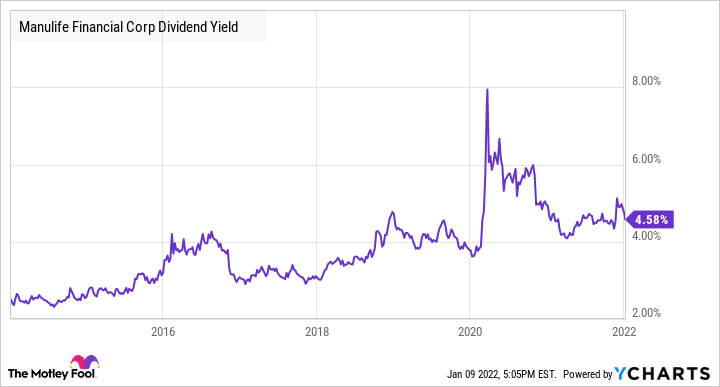1 TSX Dividend Stock to Buy in January for a 5% Yield

Written by Kay Ng at The Motley Fool Canada
On December 9, 2021, the Bank of Canada published that “the average inflation rate of goods in 2021 has been 4.4%… In the 20 years before the pandemic, goods inflation averaged only 1.4%.” So, under normal economic conditions, the recent GIC rates of about 2% for a maturity period of at least two years would suffice for Canadian savers to maintain purchasing power.
According to a Global News article published in December 2021, “BMO expects inflation to average around 3.5% in 2022, much higher than what Canadians have become accustomed to over the past 20 years, but lower than the rate seen over the past few months.”
With inflation still high relative to the last two decades, Canadians cannot keep up with inflation by earning interest income. Consequently, their purchasing power is declining.
To get more income, Canadians must look past low interest rates for higher income at the expense of making riskier investments compared to no-risk GICs. Some bonds may also provide greater interest income than GICs, but they come with similar risks as GICs with regards to sensitivity to changes in interest rates. You may be interested in the following dividend stock, which provides a juicy dividend yield.
A TSX dividend stock with a yield of more than 5%
It took some time for the market to warm up to Manulife (TSX:MFC)(NYSE:MFC) stock after it increased its dividend by 18%. The dividend hike was larger than usual, because the regulator Office of the Superintendent of Financial Institutions (OSFI) restricted Manulife and other federally regulated financial institutions like the big Canadian banks from increasing their dividends during the highly uncertain economic conditions of the pandemic. When the regulator loosened restrictions in November, these large and stable financial institutions boosted their dividends successively.
Over the last couple of weeks, the market has bid up the value stock, but the health and life insurance company remains relatively cheap. First, Manulife stock’s blended price-to-earnings ratio is about 7.9 — a discount of 22% from its long-term normalized levels. The general 12-month analyst consensus also suggests the stock is cheap with upside potential of about 20%. Second, the dividend stock is cheap based on its dividend yield. Ignoring the outlier around the onset of the pandemic, its yield of almost 5.2% is relatively high since 2014 when it started increasing its dividend annually.
MFC Dividend Yield data by YCharts
The market may still be penalizing Manulife stock for performing badly around the last financial crisis of 2007. The company isn’t getting enough credit for having maintained stable or growing adjusted earnings per share since 2012. Moreover, it has maintained payout ratios of under 40% most of the time in this period. The 2021 payout ratio is estimated to be 36%, and its 2022 payout ratio is projected to be below 40%.
The Foolish investor takeaway
Currently, Manulife stock pays out quarterly dividends totaling an annualized payout of $1.32 per share. Let’s say the dividend stock can return to a dividend yield of 4.5%. Based on its current payout, that’s a target price of $29.33, an upside of almost 15%. Throwing in its +5% dividend yield, that’s an estimated total return of 20%. Let’s not forget that this is a more conservative upside than analysts suggest. Their mean target implies 12-month total returns of approximately 25%.
The post 1 TSX Dividend Stock to Buy in January for a 5% Yield appeared first on The Motley Fool Canada.
Should you invest $1,000 in Suncor Energy right now?
Before you consider Suncor Energy, you may want to hear this.
Motley Fool Canadian Chief Investment Advisor, Iain Butler, and his Stock Advisor Canada team just revealed what they believe are the 10 best stocks for investors to buy right now... and Suncor Energy wasn't one of them.
The online investing service they've run since 2013, Motley Fool Stock Advisor Canada, has beaten the stock market by over 3X. And right now, they think there are 10 stocks that are better buys.
More reading
The Motley Fool has no position in any of the stocks mentioned. Fool contributor Kay Ng owns shares of Manulife.
2022

 Yahoo Finance
Yahoo Finance 
